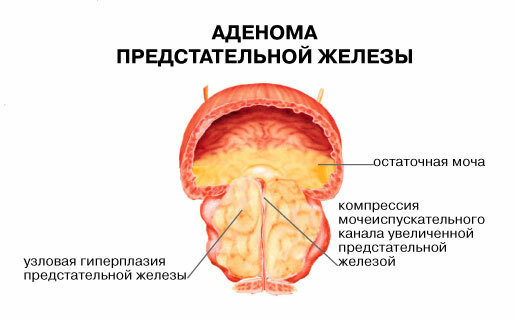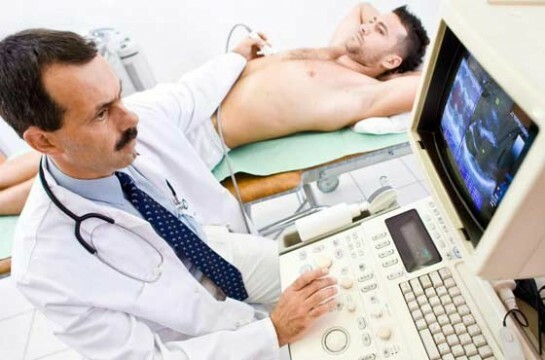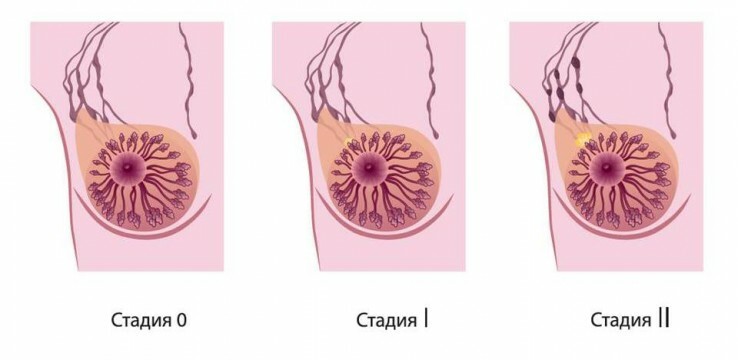Adenoma or benign prostatic hyperplasia is a disease common in men over the age of 45-50 years. A smaller percentage of cases are among middle-aged patients. Pathology is diagnosed in half of patients suffering from urological disorders. More than 80% of males face this problem. The following aspects increase the risk:
- sedentary work;
- lack of exercise;
- nerve strain;
- constant stress;
- poor environmental conditions;
- interaction with potent, toxic agents;
- wrong power supply.
Varieties and stages of development of neoplasm

The tumor is formed from epithelial tissue or fibromuscular stroma of the gland. Distinguish:
- is a sub-tubular( directed to the rectum);
- retrotrigonal( localized under the bladder);
- intravesical.
At the initial stage, corresponding to the stage of compensation, men are worried about frequent urination, feeling of incomplete emptying of .Particularly expressed discomfort at night. This leads to a violation of a proper rest, subsequent depletion of the nervous system. Radiographic studies performed during the period of exacerbation show
the absence of residual fluid in the cavity of the urinary tract .The first degree can last several years without visible progress. Early detection helps prevent complications. The initial form is influenced by medicamental and physiotherapy, folk methods. It is recommended to perform therapeutic exercises, to observe dietary nutrition. Symptomatic treatment is carried out by pharmacological means.The second stage - subcompensation - is characterized by a similar symptom with the addition of intermittent urination .The difference lies in the presence of the remains of urine in the bladder, inflammation develops, often hematuria( bloody impurities).Stressful condition, strong alcohol intoxication can lead to complete inability of a man to urinate .Such difficulties encourage the patient to strain the abdominal muscles. Excessive efforts contribute to the emergence of a hernia, prolapse of the intestine. Stress helps to remove a special set of exercises. In acute course, there is pain in the groin, giving back. Effectively conservative treatment, less often operation is required. At this time it is important to adhere to a balanced diet to prevent stagnant processes.
At the third degree - decompensation - is observed involuntary, portioned discharge, associated with a weakening of the sphincter , muscle fibers. Recommended installation of the urinals. The condition of a man can get worse. Against the backdrop of lack of appetite, weight loss, constipation, and intoxication take place. It is important to follow the rules of rational nutrition. Stagnant phenomena lead to kidney dysfunction, inflammation of the urinary tract. Possible hyperthermia, increased sweating, upset stomach, intestinal tract, nausea, vomiting. Operation is required. During the rehabilitation period, a restorative course of medications, medical exercises is prescribed.
Symptoms of the disease
The first clinical manifestations are of a single nature. This is the main reason that most patients ignore the change in state of health without paying attention, preferring not to seek advice from a urologist. Many people use traditional recipes, which often do not help. With a progressive course, there is an increase in the frequency and severity of symptoms. Aggravating circumstance is a mature age. The main signs of prostate adenoma:
- soreness, discomfort during urination, disorders associated with this process( incontinence, prolongation of natural urinary excretion, frequent urges, difficulty, discontinuity of the jet);
- burning in the urethra during emptying;
- sensation of constant fullness of the bladder;
- erectile dysfunction of men( premature ejaculation, weakening of erection, reduction in the number or complete absence of sperm);
- drawing pains in the perineum, areas of the sacrum, loin, above the pubis;
- suspicious discharges( bloody, mucous);
- sharp, specific smell.
Self-determination of the cause of the disorders is impossible. Reduce the soreness can be folk remedies. Then you need to seek qualified medical help.

Secondary symptoms of prostate adenoma manifest themselves as:
- malaise, loss of strength, weakness;
- thirst, drying out of the oral mucosa;
- impairment of appetite;
- permanent constipation;
- increased nervousness, irritability.
In rare cases, body temperature may increase, chills may appear. The patient may suffer from insomnia.
Reasons for
The main factor that provokes pathological changes in the urogenital system of men is the age-related changes in the hormonal background. After reaching 40 years in the body, the production of androgens - male sex hormones - is reduced. At the same time, the level of estrogen increases. This imbalance leads to abnormal growth of the prostate. Among other factors of influence:
- obesity. Disturbance of fat metabolism in men is a fertile soil for the production of estradiol;
- genetic predisposition;
- concomitant diagnoses of the cardiovascular system( arterial hypertension, hypodynamia, arrhythmia, others);
- unbalanced food with a predominance of fatty, fried foods, consumption of large amounts of salt, marinades, spices, non-compliance with the normal drinking regime;
- bad habits( abuse of alcoholic beverages, tobacco products);
- sedentary lifestyle, non-performance of general strengthening exercises, contributing to the development of stagnant phenomena.
According to studies conducted among men from 35 to 70 years of age, the frequency of sexual acts, the presence of infectious diseases, inflammation of the urogenital organs do not affect the development of benign neoplasm.
Diagnosis
The pathology is detected on the basis of the patient's complaints received. To confirm the alleged diagnosis, a complex of laboratory, clinical studies is conducted. The most informative are:
- general analysis of urine, blood( if necessary - biochemical);
- ultrasound of the urinary system( transurethral examination);
- rectal palpation of the prostate.
During the examination it is necessary to refuse to take any medications, if it is impossible to cancel, inform the doctor. As additional diagnostic measures are used:
- pneumo-, cystography;
- radiography;
- method of uroflowmetry, video dynamics;
- cystoscopy;
- test for prostate specific antigen( PSA).
PSA analysis allows you to track the dynamics of changes. To each age group of men there corresponds a certain norm of the content of this antigen in the blood:
- from 40 to 49 - 0-2.5 ng / ml;
- from 50 to 59 - 0-3,5;
- 60-70 - up to 4,5;
- Older than 70 - up to 6.5.
The doctor interviews the patient using a questionnaire consisting of questions about the symptoms of the disease. The evaluation of each male response corresponds to a special scale. Summarizing the total number of points, the specialist makes a conclusion about the presence of prostatic hyperplasia in a particular case.
Prevention

The most effective preventive method is a healthy lifestyle. Physical activity takes a special place. Regular exercise, walking outdoors normalize metabolism, improve blood circulation, prevent the deposition of adipose tissue, stabilize body weight. The system of therapeutic exercises includes the elaboration of the muscles of the press, the lumbosacral zone. A balanced influence has a balanced diet. Important:
- include in the diet fresh fruit, vegetables;
- to exclude hot, salty, fatty foods;
- nutrition should be rich in vitamins, minerals, beneficial trace elements.
Therapeutic treatment of
Treatment of prostatic adenoma depending on the degree and severity of the flow suggests a conservative or radical effect on the body. In the early diagnosis of , drugs that have an antispasmodic effect on the urinary tract ( group of alpha-blockers), inhibitors of alpha-reductase, slowing the abnormal growth of adenoma are prescribed. The exact dosage and duration of administration is determined by the attending physician.
Self-treatment is dangerous to health. For example, drugs that inhibit the growth of the gland, have side effects - a decrease in libido, erectile dysfunction and other. Used on a plant-based basis, with vasodilating, diuretic action.
An effective addition to the course of medications is physiotherapy, in particular, exposure to a magnet. The course of procedures is prescribed depending on the stage of the disease, it consists of at least 6 sessions lasting about 15-20 minutes. The mechanism of magnet treatment is the effect of magnetic radiation on the problem area, which improves blood circulation, accelerates metabolism in the body. Exposure to a magnet helps to reduce the patient's discomfort.
Surgical intervention
In the absence of improvement after the drug course, the operation is considered. The following methods are used:
- open-type stage-by-stage prostatectomy( adenectomy).The operation is performed under general anesthesia. First remove the prostate, form a hole to drain the liquid. The second approach restores natural urination. Manipulation requires a long rehabilitation;
- transurethral resection - excision is carried out in part, restraint of further tissue growth is due to pharmacological agents;
- laser vaporization - the principle of irradiation is applied;
- needle ablation - the operation is performed with the help of a cystoscope, the needles that conduct radio waves are injected into the neoplasm. The tissue is heated, destruction occurs;
- focused ultrasound of high intensity - an operation based on the destruction of cells under the influence of ultrasound;
- cryodestruction - transurethral surgery with the application of freezing of the pathological zone;
- dilated balloon, stenting - the urethra is enlarged with a balloon, a stent. An enlarged lumen facilitates the excretion of urine, the operation does not affect the volume of the gland.
Modern methods of treating prostate adenoma include embolization of its arteries. A new solution to the problem is to block the access of blood to the affected tissue. Through the catheter in the femoral artery are introduced plastic balls with a radius of 0.05-0.2 mm. Movement of blood flow is transferred to the vessels of adenoma, clogging them, blocking access. This helps reduce the amount of adenoma.
Surgical operation is the only way to completely get rid of pathology. The rehabilitation period is accompanied by the implementation of simple exercises that help the rapid restoration of functions, as well as strict adherence to proper nutrition. The use of pharmacological agents can temporarily restrain tissue growth.
Folk methods are not very effective.



